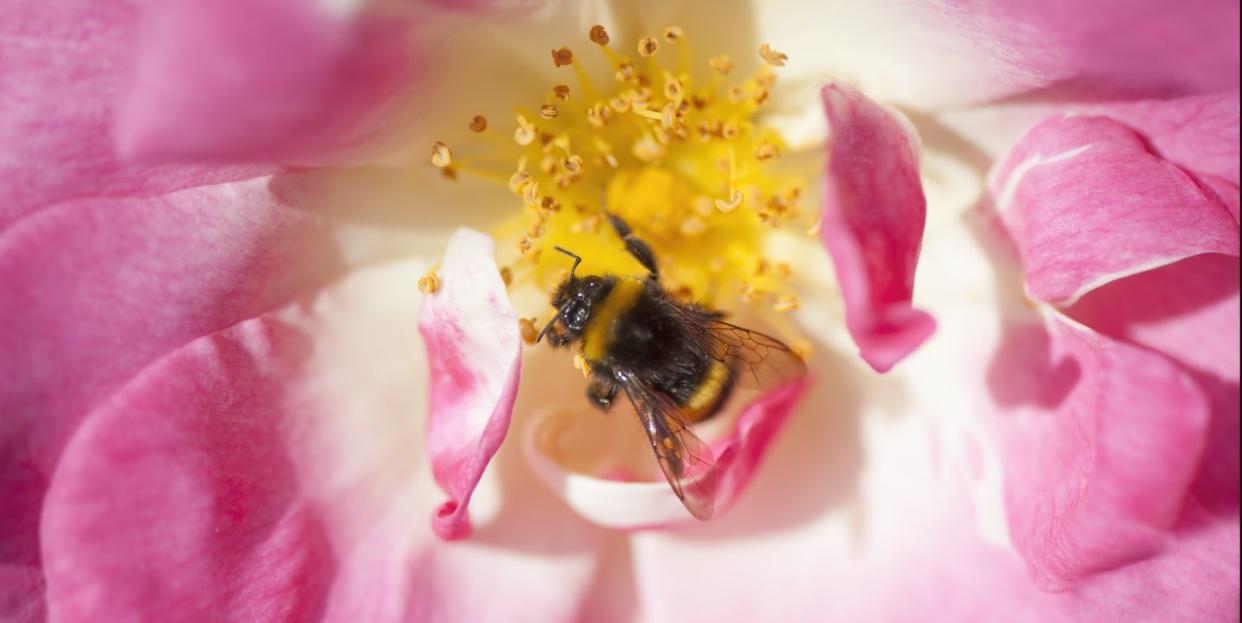Scientists Warn Almond Milk Is Destructive for the Environment

In a world where many majestic animals are increasingly endangered due to climate change, the plight to save the honeybee may not seem as dire as it truly is. For agricultural experts and conservationists alike, the general decline of the honey bee (and the 4,000 species of wild bees overall) has been quietly alarming for many years — but recent data suggests that the decline has turned into a full-blown freefall.
Bee colony deaths surpassed all-time highs last year, with beekeepers reporting an average loss of 38% of honeybee colonies in the winter season, per a 2019 survey issued by the Bee Informed Partnership, a nonprofit established by the United States Department of Agriculture. But what has caused the death of upwards of 40 to 50 billion honeybees last winter, you might ask? According to a new feature published by The Guardian this week, the American almond industry may be tipping the scales with their huge demand for honeybees to pollinate their orchards, and could be to blame for the loss of billions of bees over the last year alone.
Jennifer Sass, Ph.D., a senior health scientist for the Natural Resources Defense Council, says that the almond industry isn't totally responsible for the decrease of honeybees in particular. After all, there's an onslaught of pathogens and parasites found in nature, plus habitat fragmentation — which is "similar to a food desert for bees, since they only forage for food in areas within one to two miles away. If they're in an area that doesn't have enough blooms, it's a disadvantage," Sass says — to worry about. But Sass says the popularity of almonds (everything from whole nuts to the varieties used in plant-based milks) has created even more stress, as almond farmers are "so reliant on the honeybee to pollinate their crops, exclusively."
How almond growing impacts the environment:
Per the latest data from the Agricultural Marketing Resource Center, the American almond industry has been growing steadily. Each American, on average, consumes more than two pounds of almonds each year, found in products like almond milk, cereal mixes, and packaged snacks (everything from sweet treats to granola bars). Since the demand has been so high, almond growers have started to farm their fields earlier than ever. A recent NPR report claims that some almond farmers are using pollen and nectar substitutes to get bees to repopulate their hives in the dead of winter, when bees are supposed to be dormant. And even if the farmers don't pull bees out of their hibernation period early, global warming and rising temperatures may do it for them, Sass says. "There could be a couple of unseasonably warm days in a row, and the bees in a single colony could all come out of hibernation in early spring, but they'll die because they could be missing a food source as the flowers haven't bloomed just yet."
But the biggest killer isn't the weather or a lack of food — it could be the pesticides used by all commercial farmers in their fields, even those outside of the almond industry. Pesticides, including clothianidin and dicamba, can work to slowly impact the honeybees' immune systems and their reproductive cycles."The commercial almond growers make such a difference here. If they decide to go completely organic, or use other measures to keep all chemicals and pesticides out of their fields and trees, it makes a big difference for all bees," Sass says.
What can you do to help wild bees?
There are countless organizations that have sprung up over the years to help consumers understand which products have been made sustainably with bee colonies in mind, including "Bee Better," which also works to plants blooms among almond trees to promote successful seasons. But if you have the space in your own home, you too can aid all wild bees. "Keep chemicals out of your garden and off your blooms," Sass says, advising that no commercial products should be sprayed on or near trees, flowers, or even common sidewalk areas. "Plant things that bloom in off seasons — I try to think of times when bees may have less food, so I might plant things that typically bloom in fall or winter."
Believe it or not, wild clover is one of the best assets any bee can have in the wild. "People should mow their lawn less, and mow it a little higher, because that allows clover to grow into it," she shares, adding that clover and any other blooming weed can also provide pollen and nectar for bees in off seasons. "If I see clover growing in a lawn, I know two things: One, that bees have a place to land and have food, and two, that homeowners aren't using harmful pesticides on their lawns."
And, yes, cutting back on your almond obsession could help preserve what's left of the dwindling honeybee population. "People should buy organic where they can, whenever they can… Almonds are a great place to go organic, even if you eat less almonds overall, because that's how we'll solve the problem in the long run."
You Might Also Like

